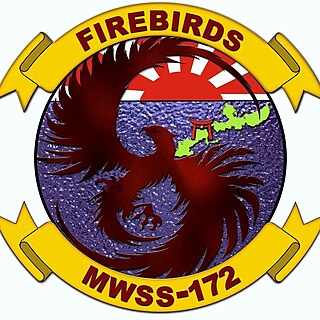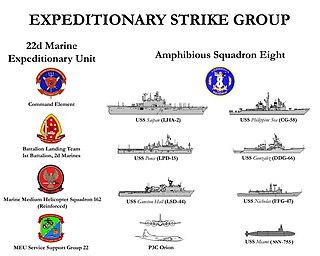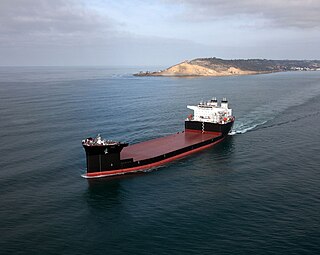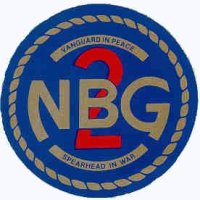The United States Armed Forces are the military forces of the United States. The armed forces consists of six service branches: the Army, Marine Corps, Navy, Air Force, Space Force, and Coast Guard. All six armed services are among the eight uniformed services of the United States.

USS Cleveland (LPD-7), an Austin-class amphibious transport dock, was the third ship of the United States Navy to be named for the city in Ohio. Her keel was laid down at Ingalls Shipbuilding of Pascagoula, Mississippi. She was launched on 7 May 1966, and was commissioned on 21 April 1967 at Norfolk, Virginia. At the time of decommissioning, she was the third-oldest commissioned ship in the US Navy, behind USS Constitution and USS Enterprise.

USS New Orleans (LPD-18), a San Antonio-class amphibious transport dock, is the fourth commissioned ship of the United States Navy to be named after the city of New Orleans, Louisiana.

The Lewis and Clark class of dry cargo ship is a class of 14 underway replenishment vessels operated by the United States Navy's Military Sealift Command. The ships in the class are named after famous American explorers and pioneers.

USNS Lewis and Clark (T-AKE-1) is an American dry cargo ship, the lead ship of her namesake class. It was the second ship of the United States Navy to be named for the explorers Meriwether Lewis and William Clark. The contract to build her was awarded to National Steel and Shipbuilding Company (NASSCO) of San Diego, California, on 18 October 2001 and her keel was laid down on 22 April 2004. She was launched on 21 May 2005, co-sponsored by Jane Lewis Sale Henley and Lisa Clark, descendants of the ship's namesakes. She was delivered to the Navy on 20 June 2006.

The United States Second Fleet is a numbered fleet in the United States Navy responsible for the East Coast and North Atlantic Ocean. The Fleet was established following World War II. In September 2011, Second Fleet was deactivated in view of the United States Government's perception that the potential military threat posed by Russia had diminished. On 4 May 2018, Admiral John M. Richardson, the Chief of Naval Operations, announced plans to reestablish Second Fleet amid heightened tensions between NATO and Russia. It was reestablished on 24 August 2018, with Vice Admiral Andrew "Woody" Lewis in command.

Military Sealift Command (MSC) is an organization that controls the replenishment and military transport ships of the United States Navy. Military Sealift Command has the responsibility for providing sealift and ocean transportation for all US military services as well as for other government agencies. It first came into existence on 9 July 1949 when the Military Sea Transportation Service (MSTS) became solely responsible for the Department of Defense's ocean transport needs. The MSTS was renamed the Military Sealift Command in 1970.
The Rim of the Pacific Exercise (RIMPAC), is the world's largest international maritime warfare exercise. RIMPAC is held biennially during June and July of even-numbered years from Honolulu, Hawaii, with the exception of 2020 where it was held in August. It is hosted and administered by the United States Navy's Indo-Pacific Command, headquartered at Pearl Harbor, in conjunction with the Marine Corps, the Coast Guard, and Hawaii National Guard forces under the control of the Governor of Hawaii.

The Landing Craft Air Cushion (LCAC) is a class of air-cushioned landing craft (hovercraft) used by the United States Navy and the Japan Maritime Self-Defense Force (JMSDF). They transport weapons systems, equipment, cargo and personnel from ship to shore and across the beach. It is to be replaced in US service by the Ship-to-Shore Connector (SSC).

Marine Wing Support Squadron 172 is an aviation support unit of the United States Marine Corps's 1st Marine Aircraft Wing. Known as the "Firebirds", they are based out of Camp Foster, Okinawa, Japan. Previously part of Marine Wing Support Group 17 before they disbanded, MWSS-172 now falls under Marine Aircraft Group 36.

In the United States Navy, the expeditionary strike group (ESG) is a coordinated group of surface ships, aircraft, submarines, and other naval assets. In contrast to carrier strike groups (CSGs), which emphasize air power and are led by a supercarrier, ESGs are strongly suited for amphibious warfare and are led by an amphibious assault ship. The ESG concept was introduced in the early 1990s, based on the Naval Expeditionary Task Force. The U.S. Navy fields nine expeditionary strike groups and ten carrier strike groups, in addition to surface action groups.

As the hub of the Marine Corps’ prepositioning programs, Marine Corps Support Facility Blount Island(MCSF-BI), located in Jacksonville, Florida, serves as the home of Blount Island Command(BICmd) and its worldwide mission of supporting the Fleet Marine Forces (FMF) who are Forward deployed and forward engaged.

An Expeditionary Transfer Dock (ESD), formerly the Mobile Landing Platform (MLP), is designed to be a semi-submersible, flexible, modular platform providing the US Navy with the capability to perform large-scale logistics movements such as the transfer of vehicles and equipment from sea to shore. These ships significantly reduce the dependency on foreign ports and provide support in the absence of port availability. The class also houses a sub-class variant called the Expeditionary Mobile Base (ESB), formerly the Afloat Forward Staging Base (AFSB).

USNS Montford Point (T-ESD-1),, the lead ship of her class of Expeditionary Transfer Docks (ESD), is a ship named in honor of African American Marine Corps recruits who trained at Montford Point Camp, North Carolina, from 1942 to 1949. After $115 million was allocated for long-lead time material and advanced design efforts, in late 2010 General Dynamics's National Steel and Shipbuilding Company was awarded the contract, worth approximately $500 million, to build the first of three planned vessels.

USNS John Glenn (T-ESD-2), is a United States Navy Expeditionary Transfer Dock ship named in honor of John Glenn, a Naval Aviator, retired United States Marine Corps colonel, veteran of World War II and the Korean War, astronaut, and United States senator.

USS Lewis B. Puller (ESB-3), is the first purpose-built expeditionary mobile base vessel for the United States Navy, and the second ship to be named in honor of Chesty Puller. She is the lead ship of her class of expeditionary mobile bases and is also a sub-variant of the Montford Point-class expeditionary transfer docks. Lewis B. Puller replaced USS Ponce with the U.S. Fifth Fleet in the Persian Gulf in fall 2017.

Naval Beach Group Two, (NBG-2) is a United States Navy amphibious unit based at Naval Amphibious Base Little Creek, Virginia Beach, Virginia. Naval Beach Group One is its sister unit based in Naval Amphibious Base Coronado in Coronado, California.

USNS 1st Lt. Baldomero Lopez (T-AK-3010) / (AK-3010), is the third ship of the 2nd Lt. John P. Bobo-class cargo ship built in 1985. The ship is named after First lieutenant Baldomero López, a US Marine who was awarded the Medal of Honor during the Korean War.

USNS 1st Lt. Jack Lummus (T-AK-3011),, is the fourth ship of the 2nd Lt. John P. Bobo-class cargo ship built in 1986. The ship is named after First Lieutenant Jack Lummus, an American Marine who was awarded the Medal of Honor during World War II.
















